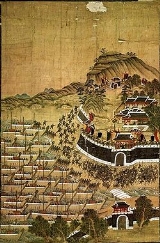
Nose tomb
Encyclopedia

Human nose
The visible part of the human nose is the protruding part of the face that bears the nostrils. The shape of the nose is determined by the ethmoid bone and the nasal septum, which consists mostly of cartilage and which separates the nostrils...
or other body parts that were severed from Koreans and brought back to Japan
Japan
Japan is an island nation in East Asia. Located in the Pacific Ocean, it lies to the east of the Sea of Japan, China, North Korea, South Korea and Russia, stretching from the Sea of Okhotsk in the north to the East China Sea and Taiwan in the south...
as trophies during the Japanese invasions of Korea in the late 16th century. War trophies were a part of Japanese tradition at the time and samurai
Samurai
is the term for the military nobility of pre-industrial Japan. According to translator William Scott Wilson: "In Chinese, the character 侍 was originally a verb meaning to wait upon or accompany a person in the upper ranks of society, and this is also true of the original term in Japanese, saburau...
warriors were often paid according to how many they collected.
One such nose tomb was discovered in 1983 in Okayama near Osaka
Osaka
is a city in the Kansai region of Japan's main island of Honshu, a designated city under the Local Autonomy Law, the capital city of Osaka Prefecture and also the biggest part of Keihanshin area, which is represented by three major cities of Japan, Kyoto, Osaka and Kobe...
. This tomb held the severed and pickled noses of approximately 20,000 dead Koreans which were eventually returned to Korea in 1992 and cremated. A similar tomb still exists today in Kyoto
Kyoto
is a city in the central part of the island of Honshū, Japan. It has a population close to 1.5 million. Formerly the imperial capital of Japan, it is now the capital of Kyoto Prefecture, as well as a major part of the Osaka-Kobe-Kyoto metropolitan area.-History:...
called the Mimizuka
Mimizuka
The is a monument in Kyoto, Japan, dedicated to the sliced ears and noses of killed Korean soldiers and civilians taken as a war trophy during the Japanese invasions of Korea from 1592 to 1598...
, literally "Ear Mound". In Japan, these tombs are considered relics by the few who are aware of them, but in Korea these tombs are very well known
(in the 1970s even taught to schoolchildren, and depicted in comic books) and are often a source of anti-Japanese sentiment
Anti-Japanese sentiment
Anti-Japanese sentiment involves hatred, grievance, distrust, dehumanization, intimidation, fear, hostility, and/or general dislike of the Japanese people and Japanese diaspora as ethnic or national group, Japan, Japanese culture, and/or anything Japanese. Sometimes the terms Japanophobia and...
.

